South Pacific e-Postcard #9
from Our Hawaii Adventures
12/1 to 12/15/2006
Aloha (hello)
We are here in our rental condo on the Big Island of Hawaii, the 17th and last island of our trip. There were a few moments of panic getting here. When we went to check our seats on the flight from Fiji to Honolulu at the Fiji airport, we were told that we were not in the computer and had no reservations for the overbooked flight that would be leaving in a couple of hours. This was a little confusing as we held preprinted boarding passes in our hands and had made reservations eight months previously. Pleading our case with a supervisor got us seats. Just cannot trust those dang computers!
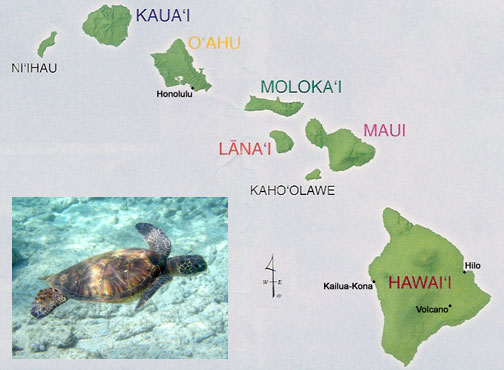
We will finish our epostcards as we started, with Q and A.
Q: How about one more history/geology lesson?
A: Sure. Hawaii is made up of six major islands (Kauai, Oahu, Molokai, Lanai, Maui, and Hawaii). They are all volcanic, with Hawaii (Big Island) formed from the lava of several volcanoes. There is an island, Loihi, forming from an undersea volcano nearby. It is about 975 meters below the water but should pop up in the next 10,000 to 50, 000 years. I understand they are taking down payments on future condos there (just kidding). The islands are over a hot spot on earth so as the tectonic plate moves new islands are formed.
The big island of Hawaii is the newest one and still has active volcanoes (see below). It is has many hills and areas of black lava rock, much of which has little or no vegetation and no buildings. Due to variations in the trade winds, parts of the Big Island are desert dry with cacti while other parts are lush rainforest.
Hawaii's location also means earthquakes. The west coast of the Big Island had one about two months ago measuring 6.7. Most the buildings had little damage but a huge hotel nearby closed due to structural problems. Earthquakes here are a common occurrence (39 in the last two weeks) but most are fairly small.
Q: How is Hawaii different from the other islands you have visited? How is it the same?
A: The state of Hawaii is a funny combination of the familiar and the exotic. Of course, here we use English, spend the dollar, and see (but do not visit) McDonalds and Pizza Hut. (We must admit that we have been to Taco Bell but only since Tim was experiencing serious withdrawal symptoms.) However, the palm trees, coral reefs, ocean waves, tropical fish, and tourist trappings remind us of the other islands we have seen. We do not see the third world poverty and housing here, although it may exist elsewhere in the state. There have been a few street people, but generally, it feels like home.
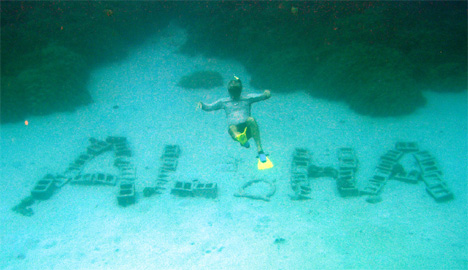
Q: What about the language?
A: Obviously, the primary language is English. However, most of the place names are in Hawaiian. This language has five vowels (a, e, i, o, u) and only eight consonants (h, k, l, m, n, p, w, and single quote). The quote is counted as a letter and means a slight pause. Since that symbol does funny things when sent over email, I will be leaving them out of the names. I think the Hawaiians beat the Germans for word length. For example, the Hawaii state fish is Humuhumunukunukuapuaa, also called the Picasso triggerfish for its strange coloring. We have made several wrong turns because the street and city names look so much alike when you are driving by, like Kealakekua and Keawekaheka.
This is the Aloha State. The word "aloha" means hello, welcome, goodbye, and love. It is also used to describe the friendly, generous attitude Hawaiians have. You see the word everywhere. We were snorkeling in a bay and saw ALOHA spelled out in bricks on the sand about 20 feet underwater!
Q: Where have you been staying and what have you been doing on the islands?
A: On a previous trip, we visited Kauai and Maui. Tim had also been to Hawaii, but Di had not. So Hawaii and Oahu is where we went.
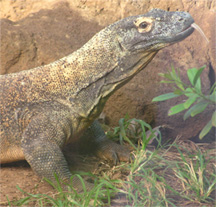
Honolulu, Oahu: We flew into Honolulu on Oahu, rented a car and drove the short distance to Waikiki. We stayed in a hostel, two blocks from Waikiki Beach. The hostel room was small and had minimal facilities, but the location was great. Waikiki is blocks and blocks of high rise hotels, high end clothing stores, cheap souvenir shops, Starbucks, restaurants, and the ever present ABC shops (which sell tee shirts, beach mats, drinks, and a few necessities like suntan lotion and sunburn lotion). During the day, people wander hang out on the beach swimming, burning, or attempting to surf. Day and evening, they walk up and down the strip, window shopping. The stores are open until midnight.
Despite where we live, we are not ones to hang out at the beach. Instead, we visited some of the nearby sights, walking there when we could. The Waikiki Aquarium was a few blocks away and had wonderful displays. It was the first time either of us had seen a live nautilus, a sea creature with a spiral shell that lives 100 to 300 meters deep. There was also a great jellyfish tank that went floor to ceiling. Di could watch them for hours! We also walked to the Honolulu zoo, which is not large but had a Komodo dragon. There is also a collection of nene, the endangered native Hawaiian goose. Its feet have evolved to be able to walk over rough lava rock.
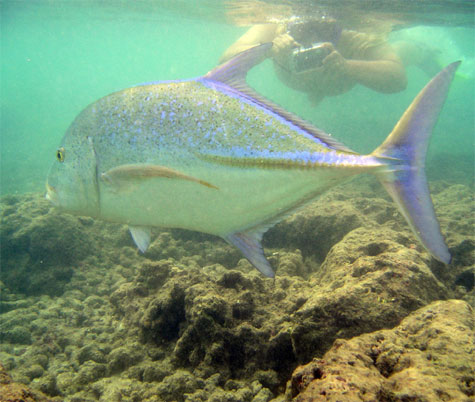
Throughout our entire trip, we have been hearing about the Bishop Museum, one the first places to collect and study cultural artifacts from the South Pacific Islands. Several people we met had studied or given talks there, so we had to visit. Although the museum is not large, the exhibits were quite diverse. There was a collection of the capes made for Hawaiian royalty involving 100,000s of colorful feathers. We also saw a wonderful display on volcanoes including a demonstration where rock is melted, poured, and allowed to cool/crack like lava, and had a hula lesson. A special display examined how the Japanese were involved for centuries in Hawaiian culture. There is a large Japanese/Hawaiian population here. It is not only apparent from looking at the local people and last names, but from the types of food in the supermarkets (lots of oriental but no Indian) and that rice is on every restaurant menu (even for breakfast!).
Of course, we had to snorkel, if possible. We went to the popular Haunama Bay Nature Preserve, just past famous Diamond Head. To get in, you were required to watch a video on how to protect the coral. This is the first time we have had to do this, and it is really a great idea. As elsewhere in the South Pacific, the coral reefs are struggling to survive. Still, Tim had to yell at some guy not to stand on the coral, so we are not sure if people are paying attention. There were lots of fish for an area with so many snorkellers and Tim took some great photos of a group of large fish circling Di (Not that she looked fishlike; she was probably in their territory!)
If you get out of the touristy areas of Waikiki, it is a great place. We did not have time to see some of the other sites like the Dole pineapple plantation or the Pearl Harbor memorials. So, I guess we will have to return.
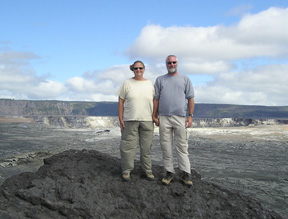
Volcano, Hawaii: After three nights on Oahu, we flew to the Big Island and drove straight to Volcanoes National Park. We have been looking forward to this place for weeks. The park overlooks the Kilauea Caldera, a huge crater left after several eruptions (see attached). We stayed for three nights at a small lodge called Volcano House near the crater and the park center. Mark Twain visited this place when the caldera was full of lava and wrote, "The smell of sulfur is strong, but not unpleasant to a sinner." Although the lava is gone, you can still smell sulfur as you go around Crater Rim Drive. It has great viewpoints, steam vents, and a lava tube you can walk through. A short walk along Devastation Trail showed how lava could wipe out all vegetation, yet decades later the plants start to grow again. Taking the 20 plus mile road from the crater to the ocean, you pass several areas of fairly recent lava flow (1970s and 80s) and a collection of petroglyphs carved into older lava rock. As this road was entirely downhill, Tim was able to turn off the engine and coast in neutral for most of the way. What an eerie feeling, no car noise.
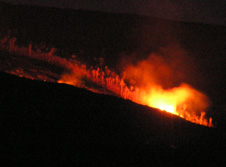
The highlight of this visit starts at about 4 p.m. You park your car at oceanside and walk over lava rock to find a good view of the mountainside and the sea. As the sun sets, you can start to see the glow of lava flowing downhill. It has been flowing since 1983 from a lava tube connected to Kilauea. Another lava tube empties directly into the ocean so there are intermittent flashes of lava with constant billowing steam. Although we are quite a distance away, the view is still breathtaking. Quite frankly, I do not think I would want to be much closer. Kilauea is considered overdue for an eruption. Later that evening, you turn on your flashlights and walk over mounds of lava rock back to the car. This is no easy task. There is no path so you walk over very uneven terrain looking for the flashing signal lights that are .3 miles apart. There are slippery gravel type areas, large ankle snapping fissures, and lots of places to trip. Di may be wearing all-terrain shoes but she is not necessarily an all-terrain girl. However, we made it back without injury. And we enjoyed it so much we went out further the next night. This time, despite having fresh batteries, Di's flashlight stopped working so Tim led the way as Di followed. This is a little more harrowing, but the adrenaline kept us going (as well as the threat of getting lost and having to sleep on lava rock).
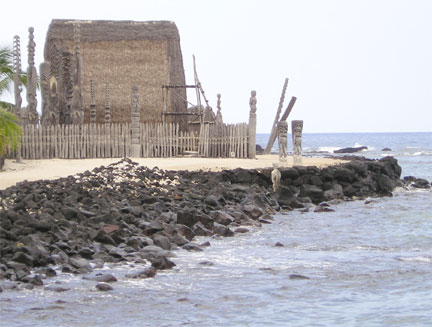
Kailua/Kona, Hawaii: Our last stop is six nights on the Kona Coast of the Big Island. We rented a condo via the Internet. The place is spacious and located close to markets, the ABC, and snorkel sites. However, the "partial ocean view" advertised is only available if you stand in the far corner of the lanai (screened porch) and wait for the breeze to blow the palm leaves. Then you may catch a glimpse of the ocean if you are quick and lucky. But we do not spend much time here. We have been visiting the nearby archeological sites, which include royal stone fish ponds, lava rock walled temple sites called heiau, petroglyphs, and places where the Hawaiian chiefs held court. All of these are along the ocean and some cover quite large areas. Some of the sites are maintained within exclusive resort/condo complexes. Entrance is free or just a few dollars and the sites are well signed with maps provided.
Since Hawaiian beaches cannot be privately owned, there is easy access to a variety of snorkeling sites. We have been to three of them. The most interesting was Puuhonua o Honaunau (Place of Refuge). It was a place where natives who had committed crimes (kapu, like the word tabu) could stay, if they could reach it by swimming the nearby bay. Since anyone who broke a kapu was punished by death, this was one popular place. A few days stay and a quick ceremony by a priest, and you could go home forgiven and your crime forgotten. To snorkel on the bay, you entered via a small sandy beach, through cold fresh water, over high coral heads topped by shallow water then through a strong current to the reefs. The reward? Sea turtles that you could watch and photograph to your heart's content. They are used to humans so they do not all swim away. In fact, on the trip back to shore, we practically crawled over the coral (trying not to touch it) and found a big old turtle on the other side, checking us out. This one was just a little too close for comfort, but he (she) did not seem to mind. We also saw the Hawaii state fish, Humuhumunukunukuapuaa (actually, I just like typing that word).
A drive around the northern half of the island took us to the foot of Mauna Kea, an extinct volcano visible for miles. At the summit are twin telescopes/observatories considered the world's best. The summit is always above the clouds and, since all streetlights on the entire island are muted yellow, there is little ambient light.
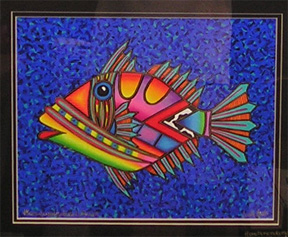 Going to the summit (13,000 feet high) as a non-astronomer involves taking your 4WD vehicle over gravel road or paying about $185 per person for an all day excursion. At the top, you can look through telescopes brought by the tour leaders, but not the big important telescopes. Since we thought the price a bit steep (no pun intended), we were satisfied by driving as far up as the visitor's center (9,000 feet high). Our compact rental car was pushed to the limit anyway as we could smell something burning when we stopped at the center. Luckily, Tim could almost coast downhill, so there was no permanent damage (we think).
Going to the summit (13,000 feet high) as a non-astronomer involves taking your 4WD vehicle over gravel road or paying about $185 per person for an all day excursion. At the top, you can look through telescopes brought by the tour leaders, but not the big important telescopes. Since we thought the price a bit steep (no pun intended), we were satisfied by driving as far up as the visitor's center (9,000 feet high). Our compact rental car was pushed to the limit anyway as we could smell something burning when we stopped at the center. Luckily, Tim could almost coast downhill, so there was no permanent damage (we think).
Our last day was spent picking up those remaining souvenirs, a short trip to a coffee plantation (Kona coffee is well known to coffee aficionados), and trying to get all the stuff we bought into our bags. An overnight in Hilo and a very early morning start on the Hilo to Honolulu to Los Angeles to Detroit return finishes this trip. It is time to come home and face the prep work for classes, holiday shopping, and Michigan winters. Thanks to all of you who read our epostcards and those who sent us responses. We have missed our family and friends. But in a month we will probably miss this Hawaii weather!
Mahalo (Thanks) and Hau'oli Makahiki Hou (Happy New Year) to all of you.
Di & Tim
P.S. The photo count is currently over 3,000. Not all of them are keepers, but sorting them out will keep Tim out of trouble for a while.
 Going to the summit (13,000 feet high) as a non-astronomer involves taking your 4WD vehicle over gravel road or paying about $185 per person for an all day excursion. At the top, you can look through telescopes brought by the tour leaders, but not the big important telescopes. Since we thought the price a bit steep (no pun intended), we were satisfied by driving as far up as the visitor's center (9,000 feet high). Our compact rental car was pushed to the limit anyway as we could smell something burning when we stopped at the center. Luckily, Tim could almost coast downhill, so there was no permanent damage (we think).
Going to the summit (13,000 feet high) as a non-astronomer involves taking your 4WD vehicle over gravel road or paying about $185 per person for an all day excursion. At the top, you can look through telescopes brought by the tour leaders, but not the big important telescopes. Since we thought the price a bit steep (no pun intended), we were satisfied by driving as far up as the visitor's center (9,000 feet high). Our compact rental car was pushed to the limit anyway as we could smell something burning when we stopped at the center. Luckily, Tim could almost coast downhill, so there was no permanent damage (we think).






